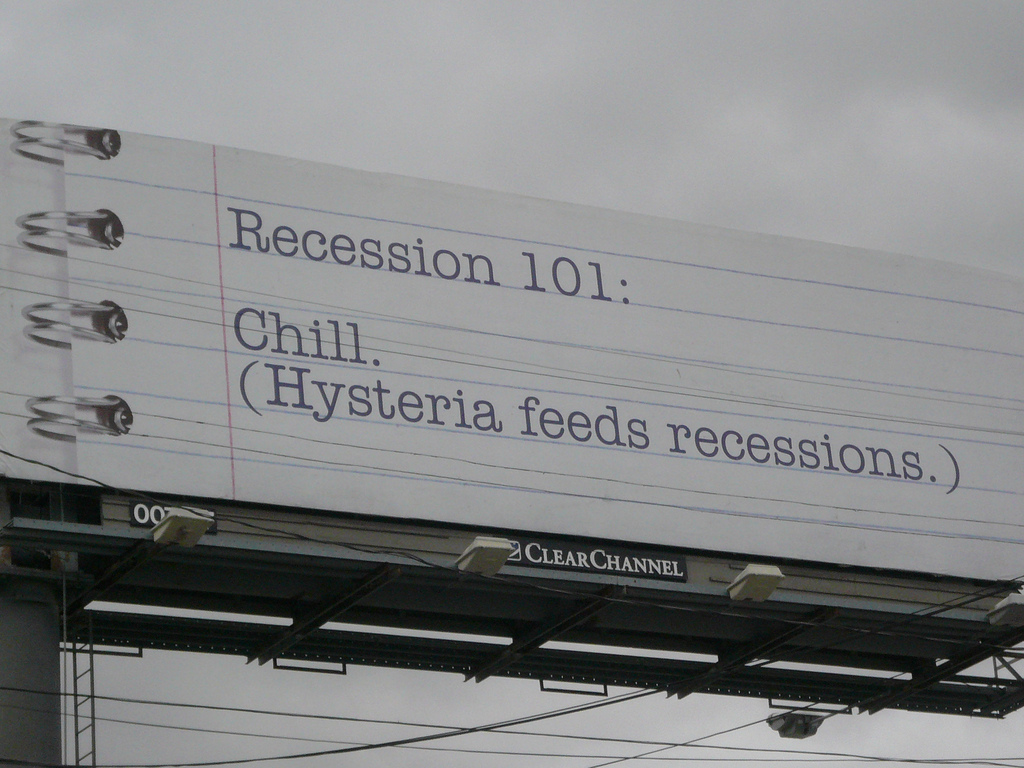
“VICTORIA is on the brink of recession and South Australia and Tasmania are already in one, as the high dollar, high interest rates and government spending cuts slowed Australia’s economic growth in the December quarter to just 0.4 per cent.” – Tim Colebatch / The Age – March 8, 2012.
Add to this reasoning a drop in retail spending linked to concerns over Europe’s debt crisis and the relentlessly negative narrative emanating from Canberra.
We now have an Australian public that is willing itself into recession as many governments actively drive us there for fear of breaking the budget surplus promise.
But recessions are part of a market economy – what goes up must come down. The question is, how far will we fall, how hard will we hit the ground and how long will it take to recover?
Seth Godin believes there are two recessions: The first is the cyclical one, the one that inevitably comes and then inevitably goes. There’s plenty of evidence that intervention can shorten it, and also indications that overdoing a response to it is a waste or even harmful. The other recession, though, the one with the loss of “factory jobs” and systemic unemployment – is here forever.
On the latter let’s just say Australia is walking deep into a ‘forever recession’ with no real idea of what to do about it. I’ll leave any deeper discussion to another blog article on Australian productivity (dangerous can of works to open, that one.
On Recession Mark I, business leaders need to start considering right now what changes to their businesses and marketing are required to keep the customers coming – and maybe even help slow and soften Australia’s fall.
There are some key factors companies should consider when making their marketing plans for FY 2013. After all, although the context and severity may change, people’s emotional make-up really hasn’t changed for millennia.
1. Get insight.
When behaviour is changing you need to know why and respond accordingly. Understand how customers are now perceiving value. Do they want more for the same investment? In a recession, customers take more time making decisions, negotiate harder and are more willing to postpone purchases, trade down, or buy less (just ask Australia’s retailers). Trusted brands are especially valued. If you have one, leverage your legacy. If you don’t, redirect your positioning for loyalty and integrity. Although some brands can launch products successfully, most wont because hype can work against you. Although the top end of town may still spend up, they’re less likely to talk about it. Corporate art collections always get sold down in a recession.
2. Embody family.
In times of hardship, people go back to community and family. For some it’s to lick the wounds, others the guilt of being too avaricious during the boom. But, for most of us, its a natural reaction to the storm and an uncertain future. Families stay at home (retail analysts call it cocooning). Advertising needs to feature family scenes not celebrations of excess. Competitive, extreme sports and risk taking are out. Crazy humour makes light of the dark situation and fear campaigns make the night darker: both are gone. Traditionally, greeting card sales, telephone use, and spending on home furnishings and home entertainment are maintained. In case you thought family love extended to more kiddies, condom sales were up 10.2% in the US in 2009. Kids are just too damn pricey.
“The American consumer is clearly getting back to basics,” says Todd Hale (March 11, 2009) – Nielsen’s Senior Vice President of consumer and shopping insights. “The philosophy out there seems to be ‘If you can’t eat it, you don’t need it.'”
3. Maintain spend.
Hold your nerve: your gut instinct is often wrong. In a recession, brands that increase advertising when competitors are cutting back improve market share and return on investment at lower cost. More consumers at home means more watching TV, reading the paper, surfing the net. Make sure you’re visible. As those of weak nerve pull their campaigns, the strong negotiate better advertising rates and often lock them in for the coming years as the recession lifts. Granted, if sales are down, you may not have the cashflow so its time to consider your options: maintain the frequency of advertisements but reduce length from 30 to 15 seconds, substitute radio for TV, increasing direct marketing (including incentivised email marketing).
“Opportunities go begging in a market ripe for the brave.” David Redhill – Chief Marketing Officer, Deloitte
4. Be social.
The internet provides the opportunity to match entertainment offers with sales offers. Head online to map the interests and networks of customers. Using social media, match your offer to their shifted values. Create a micro site with tips on how your products and/or services are a family’s best friend during tough times. Make the experiences interactive, gaining a licence to keep communicating more regularly via email and social media feeds.
5. Adjust, adapt.
As consumers seek products and services that stress good value, companies must re-forecast demand. In a recession we prefer all rounders to specialists and we don’t respond to all the added options. This is also an opportunity to make the decisions that should have been made earlier: prune services and product lines; consider more efficient models of distribution and delivery. In supermarkets in-house brands outperform manufacturer labels. B2B customers want transparency; to see all the detail in the pricing. Promote dependability, durability, safety, and performance. New products should address the new customer psychology and stress price performance.
6. Price well.
Customers will shop around for the best deals but that doesn’t necessarily mean dropping your prices. Offer temporary price promotions and quantity discounts, extend credit to loyal customers. Strong brands can price smaller pack sizes more aggressively.
“Economic recession can elevate the importance of the finance director’s balance sheet over the marketing manager’s income statement. Managing working capital can easily dominate managing customer relationships. CEOs must counter this. Successful companies do not abandon their marketing strategies in a recession; they adapt them.” – John Quelch / HBR – March 3, 2008.
7. Core values.
Providing reassurance should be at the centre of the customer experience. Even though many companies will be making employees redundant, managers must assure employees the company is resilient while emphasising the importance of quality control and servicing existing customers who must feel the bond is too strong to forsake. CEOs must be visible in-store and on the shop floor – rolling the sleeves up and standing shoulder to shoulder with the people who matter.
Ellis Jones developed integrated marketing and brand differentiation strategies for Australian businesses through the GFC.
Call us on (03) 9416 0046 and we’ll share some learnings.
Image attribution: catheadsix, via Wikimedia Commons

